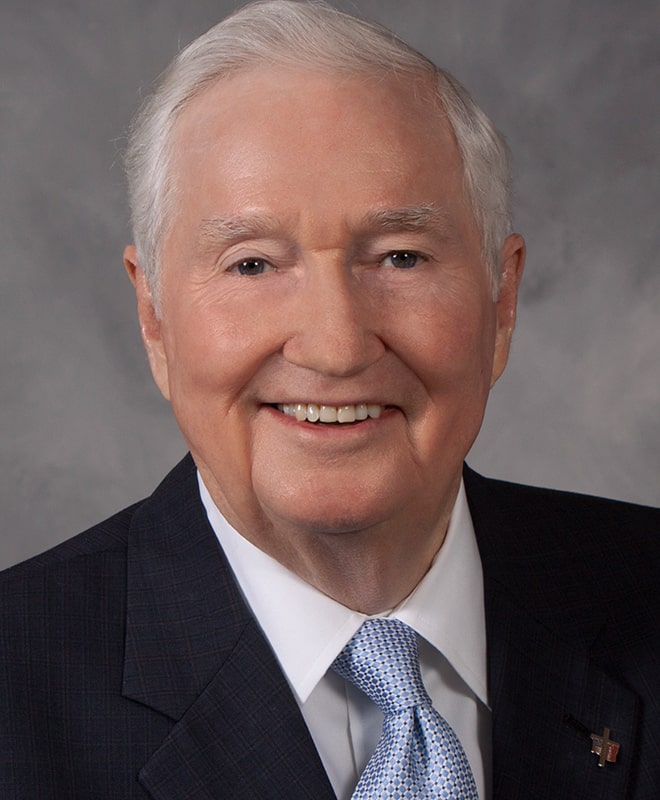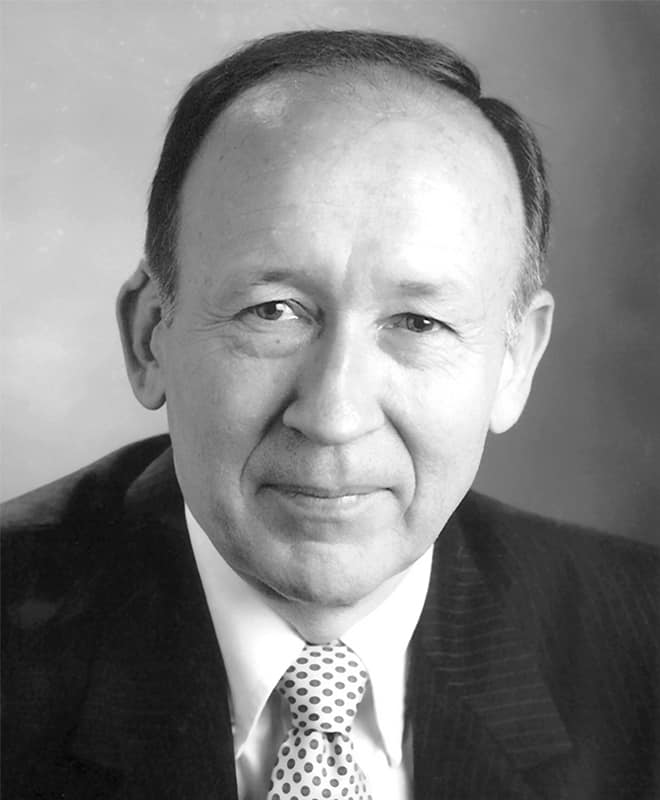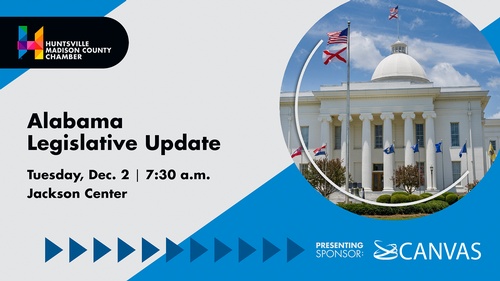Doing the Right Thing
Rocky moments in Rocket City’s growth – plus industrial leadership
By Wendy Reeves, Contributing Writer

WF Sanders Jr. took his first breath in Huntsville in 1935. Since childhood, he’s held a front-row seat to witness and participate in much of the city’s development into the thriving economic engine that it is today. He describes his experience as “a wonderful ride.”
He has vivid memories of Huntsville’s turning points in history that he shares as one of five diverse and influential leaders the Huntsville/Madison County Chamber is featuring in a special series of stories throughout 2020 called “Huntsville: A City in the Making.” Others include Hundley Batts Jr., Julian Butler, Loretta Spencer, and Charles Younger.
Sanders remembers a lot of people who had an important bearing on Huntsville’s development from a sleepy cotton town to Rocket City, a research and development hotspot, and soon to be the largest city in the state.
“Some men from back in those days we never hear about any longer, but they are the ones who began the beginning of where we are today,” Sanders said, naming off (Robert Benjamin) “Speck” Searcy Jr., George Mahoney, and Oscar Mason. “They met every morning, had coffee and talked about what can we do to maintain the vibrant agricultural community, and it was a vibrant town even back then.”
One watershed moment for the city came in the early 1950s when a new Air Force wind tunnel went to Tullahoma, Tenn., instead of Huntsville. The federal project would have created thousands of jobs.
“I was about 12 or 13 years old and had a job delivering The Huntsville Times. I was riding my bicycle down and approached where The Huntsville Times building was, and I noticed everybody looked so drab and so down.
“I went into the newsroom, and I said to the guy counting the papers out, ‘What’s going on?’ and he said, ‘You haven’t heard?’ I said, ‘no.’ He said, ‘We lost.’
“You mean, we lost the wind tunnel?’ I said to him.
“And he said, ‘yes,’ and that was just kind of a downer. I remember I sat there on the sidewalk rolling my papers, and I guess I was crying because Daddy had told me this was going to be the biggest thing that will ever happen to Huntsville.”
Soon after, it was announced that Dr. Wernher von Braun and a German rocket team were headed to Redstone Arsenal.
People then wanted to put up a statue at the courthouse of the senator from Tennessee “who beat us out of the wind tunnel,” Sanders said. “What a change that was. That was big time.”
Also during the 1950s and 1960s, Sanders saw Huntsville stick to its history of “doing things right” during the Civil Rights Movement, managing to avoid national headlines. We did have our share of problems, though. “
When Gen. (John) Medaris arrived at Redstone in the 1950s and early 1960s and discovered a highly segregated community, he called Will Halsey and Tom Thrasher (of the Huntsville Army Advisory Committee) and said “we’ve got to solve this problem,” Sanders said.
He said Halsey and Thrasher were leaders who understood how important it was to keep the Army and NASA in Huntsville, “and how the strings of Washington were being pulled to get our act cleaned up down here.”
While the community was segregated, Sanders said, the animosity between races seen in other parts of the state and across the South was not prevalent in Huntsville. The old Councill High School, which was for black students, produced many highly successful graduates, he added, and so has Alabama A&M University and Oakwood College (now University).
From Sanders’ perspective, race wasn’t an issue for him growing up. He and Batts have been friends since childhood. Sanders delivered their newspaper.
“I never heard anything out of my parents and grandparents, and I remember us having interactions with black families all my life,” he said.
However, when Medaris called, Halsey and Thrasher took action by going around to apartment complexes and night club owners of both races telling them that their businesses should be open to all races. If not, the Army and NASA would leave.
“The end result was that they did open up, and that was really the beginning of how Huntsville stayed out of the limelight over integration,” Sanders said.
At the turn of 1959 and 1960, more new leaders moved to Huntsville and came into play, like Younger, Tom Thrasher, Guy Nerren, and Louis Salmon.
“They came in and formed this group, it was probably a group of 30 to 35 people who formed the basis of industrial leadership for this community,” Sanders said. “Charlie formed the IDB, and at that time we also had an Industrial Development Association (IDA). In 1979, it became obvious to several of us, including Guy Nerren, who was a real foundation of the growth of where we’ve been in this last 25 years.”

Nerren was the first full-time executive director of the Huntsville Industrial Expansion Committee. He was hired in 1960 and ran the city’s economic development until the group merged with the Chamber. That happened because, while the city has been successful, it hasn’t always been an easy path, Sanders said. The late 1970s and early 1980s had the IDA and Chamber of Commerce “at loggerheads with each other over raising money.”
“I shall never forget. I was president of the IDA, and Guy Nerren and I met with Martha and Leroy Simms where the old hotel was downtown. We decided those two organizations had to merge, so we then met with the Chamber hierarchy because we were fighting each other to raise money, so we brought about a merger. In 1980, that merger took place, and from there is when we began the great growth process that we have now. There are a lot of names that probably should be mentioned on this. It was an excellent move.”
He called Nerren a master of putting the right people together when negotiating a deal.
“He would access the deal we wanted to come to town, and put together the right people to meet with him. You might be invited on a deal sometimes, and you might not. But he is the one who really entrenched us in a growth period,” Sanders said.
In the Cummings Research Park era, Charles Shaver, Pat Richardson, and Alvin Blackwell’s names come up. The development of the park, now the second largest in the U.S., was also incredibly important to Huntsville’s growth.
“I know you’ve driven through there and seen all the names of major corporations from across America who are there and brought a lot of jobs to this community,” he said.
The city’s growth has continued, including the most recent major announcement of the new Mazda Toyota Manufacturing plant. That development site took years to pull off.
“That our industrial board has worked so close with all organizations in this community has been a godsend for Huntsville to have this organization and the legislation we have behind it,” Sanders said. “We have never done anything outside the law around industrial development while we’ve seen other communities finance deals we would never look at. It’s part of the culture of this community to try to do things right, so I’m just delighted I’ve been a small part of it since I came back from (four years in) Birmingham – and that’s been a long time ago.”
There’s a lot of history that has built up to this moment, he said.
“The leadership of the Chamber has absolutely done a masterful job,” Sanders said. “Now I want to back up to all those years ago because one of the important things when this merger of the IDA and Chamber came about, it was made clear to the then-combined boards that we would not diminish the traditional Chamber of Commerce objectives. But the major objective of the new Huntsville/Madison County Chamber of Commerce was industrial development, and we’ve stuck by that all these years.”
Sanders also said concerns about leadership for the future don’t bother him as much these days.
“We have brought in some great leadership which has been a concern from a number of us who grew up in the old days. We’ve wondered whether we will have the leadership to carry this community forward. I can unequivocally say now that there is no question that we have that, and we’re seeing it every day in this town.”
This article appears in the August 2020 issue of Initiatives magazine, a publication of the Huntsville/Madison County Chamber.




